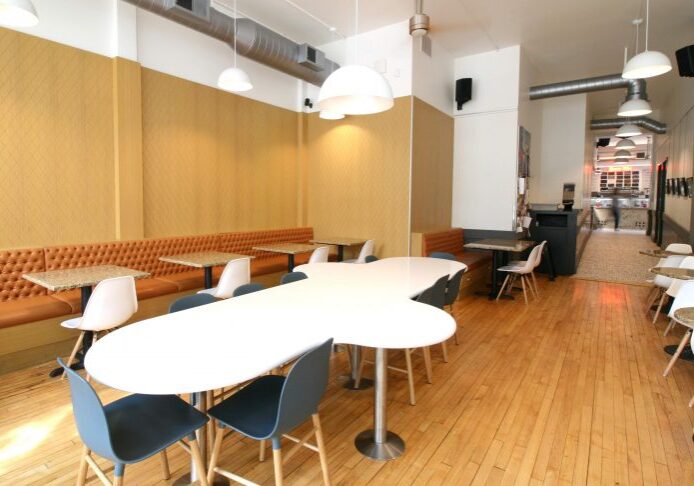
Tenso Case Study: Northland Woodworks
THE SCOOP — Quality woodworkers love a new challenge. This
summer, Northland Woodworks of Blaine, MN supplied Sebastian
Joe’s with a faux-waffle cone wall and other interior assemblies
during a remodel.
The popular shop sells handcrafted ice cream and site-roasted coffee
in the Lowry Hill neighborhood in Uptown Minneapolis. It also
operates a store in the Linden Hills neighborhood.
Matt Krig, co-operator of Northland, highlighted a hidden aspect of the
project. He said Tenso self-clamping connectors by Lamello allowed
his wood shop to more easily sell, test fit, map out and install the
waffle cone wall.
“Tenso connectors allowed us to get in and out quickly by greatly
reducing the amount of tools we needed on-site and limiting trips to
the truck in a less-than-ideal parking situation,” Krig said.
The original blueprints called for vertical seams on standard 4×8 sheets
of plywood, but Matt Krig, owner of Northland Woodworks, knew that
he needed to take a more creative approach.
There are a million ways to put it together” he said. “But how do
you put it together in the shop, guarantee it is perfect, finish it all, and
then install the job in the most efficient way possible?” Northland
utilized a zig zag design for the panel joinery. “The panels are a waffle
cone pattern, we could hide the seams better, and we didn’t even
have to worry about the veneer being on the same plane.” Krig
said. “We were able to run sample pieces on the CNC, connect
them with the Zeta, and it really helped us sell the job. We were able
to differentiate ourselves by doing that type of joinery. The architect
was concerned about the joints on the panels and we were able to
make them disappear.”
The wall panels are a rift sawn white oak veneer on a core made of
Medex brand fiberboard by Roseburg. The satisfaction is evident, and
the waffle cone wall has become a popular backdrop.
“The nice part about the joinery too is that it’s super consistent.
By using the P-System in the zig zag, we didn’t have to spline or go
along with the router and risk anything.” Krig also mentioned the
ability to limit the use of bar clamps at the job site as an advantage.
“We didn’t have to carry clamps in, which is probably one of
the biggest complaints, putting dents in drywall or hitting the floors. A
clamp falls over and dents one part of a sequence veneer job and you
are starting over.”
Lamello’s P-System proved to be an integral part in making this
a successful project. “It took fewer trips in and out, we were just going
in and making the install. We are doing the money maker thing,
instead of playing around with tools.” Krig said. “It allowed us to
make panels as big as possible, done in fewer pieces, and that was the
idea: to have as few seams as possible and to cover the wall as quickly
as we could.”
And there was one other aspect about the job that Krig says can’t be
overlooked. “The wow factor was worth something too, people
underestimate that. Clients see these guys come in, do all these funky
things on site and it’s not just about being efficient. It’s
about impressing people at every step along the way.”

North America’s Trusted Source for Striebig, Lamello, and Precision Grinding Machinery for over 75 years.
Precision vertical panel saws.
Woodworking and joinery systems.
Grinding Machines
Manufacturing & sharpening solutions.

